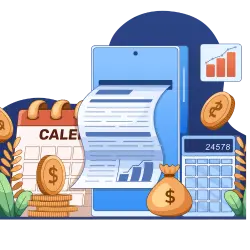TABLE OF CONTENTS
Statement descriptors are a bigger deal than you may think. They can give your customers more clarity as far as purchases they’ve made and can also help keep your business free from unnecessary financial losses. How can something so minuscule (to the point that you may not even know what they are) be so powerful? In this article, we’ll demystify the concept of billing descriptors, including what they are, how to format them, and how to optimize them to help prevent chargebacks. Let’s dive in.
What Is a Billing Descriptor?

A billing descriptor (also known as a statement descriptor or merchant descriptor) is the line item that shows up on your customer’s bank statement for each charge on their account. In other words, the information that appears on a customer’s credit card or bank statement when they make a purchase.
When you buy something at a store, whether in person or online, you’ll see a charge on your bank statement. The descriptor (i.e., the text next to the amount) is your first clue as to what that charge is. If you’ve ever seen a charge you don’t recognize, you know firsthand how important this nugget of information can be. Now, think about it as a business owner. You want your customers to immediately remember and recognize the purchase that shows on their bank statement so they never dispute one of your charges. To help them do that, you have some control over what shows up for your customers when they purchase something at your store.
A statement descriptor typically includes details such as the business or merchant name, phone number, and any additional information that helps the customer identify the transaction. That’s why businesses need to optimize their billing descriptors to help alleviate or avoid confusion for their customers.
Different Types of Merchant Descriptors
The purpose of all descriptors, as we touched on, is to provide clear and recognizable information about the transaction for both the customer’s and the merchant’s benefit.
They help customers identify and reconcile their purchases, ensuring transparency and reducing confusion. They also give you, the merchant, a preliminary defense against chargebacks. “Cardholder does not recognize the transaction” is a major and very common reason for chargebacks. It’s also one you can reduce with a clear descriptor.
So now that we know why descriptors are important, let’s talk about what they look like. Here are the types of descriptors that you can expect during and after a transaction.

Soft Descriptors
When you first process a debit or credit card, usually a hold is placed on the account to siphon off the money needed for the purchase. This makes it so the customer can’t overspend on their account while the transaction is processed.
The initial hold is called an authorization, meaning that the money has been designated but there is still no completed transaction. Since this amount is still potentially subject to adjustment (such as adding a tip), your customer will first see a soft descriptor on their bank statement right after the purchase. This soft descriptor is temporary. It will be replaced by a hard descriptor once the transaction has been finalized/settled.

Hard Descriptors
As we touched on, a hard descriptor will replace the soft descriptor once you finalize the transaction. When talking about billing descriptors, this is typically the one you’re most used to seeing: it’s used once the transaction is complete.

Static Descriptors
You can differentiate the two descriptors mentioned above (hard vs. soft) by the transaction status. The next two categories, (static vs. dynamic), relate to the composition of the descriptor itself.
A static descriptor is a concise and standardized bit of text that appears on a customer’s bank statement or credit card statement.[1]Stripe. “Statement Descriptors: Static“. Accessed on Dec 1, 2023. Either the entire descriptor can be static, or a portion of the descriptor can be static. This portion does not change from transaction to transaction. Usually, a fully static descriptor will look something like this:
SALLY’S COFFEE SHOP 888-555-1234
BATE’S FISH & TACKLE 800-123-4567

Dynamic Descriptors
Dynamic descriptors, on the other hand, refer to any additional information included in a customer’s credit card statement that is more relevant to their specific purchase. The dynamic piece is to provide even more clarity about a transaction.
When a customer makes a payment using their credit card, you can customize the dynamic descriptor to include relevant details such as the product or service description, invoice number, or any other information that would assist in identifying the transaction. This added level of detail helps customers understand what they are being charged for and reduces confusion or disputes regarding unfamiliar transactions on their statements. Here are some examples of a mix of static and dynamic descriptors with the dynamic piece highlighted:
TOM’S ELECTRIC; 888-555-1234; INVOICE 1234
ATI ROOFING; ANNUAL MAINT.; 800-123-4567
Examples of Effective Shortened Descriptors
A shortened descriptor is a static prefix to a dynamic descriptor (as shown briefly in the above examples). The prefix or “shortened descriptors” will be the same on every transaction that is made. They can get much more creative than the above examples.
Some additional examples of shortened descriptors are:
- Company name + contact information
- Company name + item purchased + location of purchase
- Company name + location
- Company name + item purchased
Role of Statement Descriptors in Chargeback Prevention
We’ve touched on this point briefly, but statement descriptors play a crucial role in chargeback prevention. They provide clear and recognizable information to customers on their credit card statements to help them identify when, where, and what purchase was made. These descriptors come in handy for customers who don’t have a daily reconciliation process and may have forgotten about the purchase they made at your store.
By ensuring that the statement descriptor accurately reflects your company name or recognizable brand, customers are more likely to remember and recognize the purchase they made. This reduces confusion and potential disputes that can lead to chargebacks. If you think about it, it makes sense: when customers see a familiar name or brand on their statements, they are less likely to dispute the transaction as fraudulent.
Statement descriptors can also include additional information, such as contact details or support channels for customers to use to reach out in case of any questions or concerns regarding their purchase. This proactive approach encourages open communication and resolves issues before they escalate into chargebacks.
Key Strategies for Optimizing Billing Descriptor
Optimizing your billing descriptors is a crucial piece of effort for businesses to ensure accurate and clear communication with their customers. It’s something you only have to set up once with your merchant service provider, and you’ll reap the rewards thereafter.

Be Simple and Clear
The first strategy is to keep billing descriptors concise and easy to understand. Using simple language and avoiding jargon or acronyms can prevent confusion and reduce the likelihood of customer disputes. For example, if your business is colloquially known as Sam’s Fried Chicken, don’t shorten it to “SFC.”
Additionally, including relevant information such as the product or service name, date of purchase, or invoice number can help customers easily identify the transaction.

Use Your Merchant Name in Descriptors
Let’s get into the naming in a bit more detail, as there are additional nuances you may not have considered.
- Use the most familiar name. For example, if your business name is “Sally’s Home Kitchen,” but your business is legally registered as a sole proprietorship named “Sally Jensen,” use the name your customers would recognize, not the legal name in this instance.
- Avoid unfamiliar or unnecessary acronyms. We touched on this already, but it’s important to use common sense. If, for example, your business is named “Smith and Smith Partners,” you may be all right using S&S PARTNERS in your descriptor because it’s still identifiable. You would want to avoid, on the other hand, “S&SP” because that would be much harder for your customers to decipher.

Incorporate Contact Information
Incorporating contact information is a smart move in the event of confusion. By including your contact information in the descriptors, you will make it a lot easier for customers to reach out to you directly with any billing inquiries or concerns instead of going straight to their bank for a dispute.
Including your contact information in the descriptors not only provides a convenient way for customers to get in touch but also adds a layer of transparency and trust.
Final Thoughts on Merchant Descriptors

Merchant descriptors are an important part of banking and merchant services. They allow customers to recognize their purchases, help build transparency, and can help protect businesses from chargebacks. Take some time to set up your billing descriptors in a way that makes sense for both your business and your customers, and you can rest assured that your chargeback prevention strategy is working for you behind the scenes. With a merchant account, your dedicated account manager can answer any questions you might have about billing descriptors for your business and provide you with more comprehensive chargeback prevention services.






